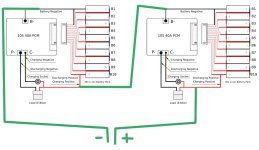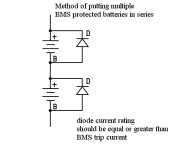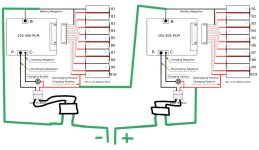chuyskywalker
1 kW
I've got a matching set of "vintage" A2B battery packs (downtube and rear rack). The cells are super old and tired (10 and 13 years old) and I'd like to replace them. They are traditionally NOT wired in parallel (each has a separate charge port) -- in fact, the whole schtick of the bike was a key switch to flip between batteries. Each pack is a 10s3p and have a built in BMS along with dedicated charge port.
While I'd like to keep them (mostly) built in their stock config (36v wiring, BMS'd as normal, and can be charged by 36v charger) I do want to run a 72v system. Normally when this is brought up the threads talk about needing to make sure each BMS won't freak out because you're passing the higher voltage across the second pack and needing to deal with one/both of the BMS individually dropping out, etc. Specifically, this all hinges on wiring the packs in series going through the individual BMS(s), i.e.:

I'm curious about a different route: pull wires out from each pack that are directly connected to the pos/neg cell ends so I can wire up a 72v series connection bypassing the individual BMS(s). i.e.:

I'm aware this would remove bms level protections; a risk I'm willing to accept (or perhaps work around with some other warning system if the BMS load pathway is opened).
Would there be risk to the BMS(s) in such usage? Or, because current/voltage for the controller isn't actually flowing through the BMS(s), this will act fine?
I just don't want to risk the BMS(s) as these are very bespoke and would be hard/impossible to replace with a generic BMS if I blow them up. (In case of uncertainty I'll just disconnect the BMS(s) entirely to avoid any issues, but having them present to handle charging/balancing sure would be nice.)
While I'd like to keep them (mostly) built in their stock config (36v wiring, BMS'd as normal, and can be charged by 36v charger) I do want to run a 72v system. Normally when this is brought up the threads talk about needing to make sure each BMS won't freak out because you're passing the higher voltage across the second pack and needing to deal with one/both of the BMS individually dropping out, etc. Specifically, this all hinges on wiring the packs in series going through the individual BMS(s), i.e.:

I'm curious about a different route: pull wires out from each pack that are directly connected to the pos/neg cell ends so I can wire up a 72v series connection bypassing the individual BMS(s). i.e.:

I'm aware this would remove bms level protections; a risk I'm willing to accept (or perhaps work around with some other warning system if the BMS load pathway is opened).
Would there be risk to the BMS(s) in such usage? Or, because current/voltage for the controller isn't actually flowing through the BMS(s), this will act fine?
I just don't want to risk the BMS(s) as these are very bespoke and would be hard/impossible to replace with a generic BMS if I blow them up. (In case of uncertainty I'll just disconnect the BMS(s) entirely to avoid any issues, but having them present to handle charging/balancing sure would be nice.)




